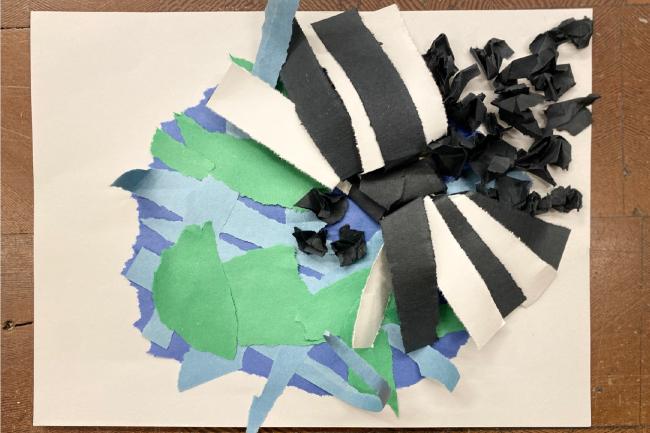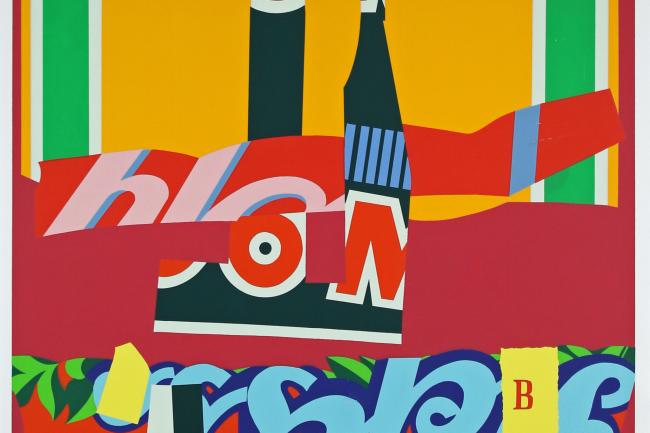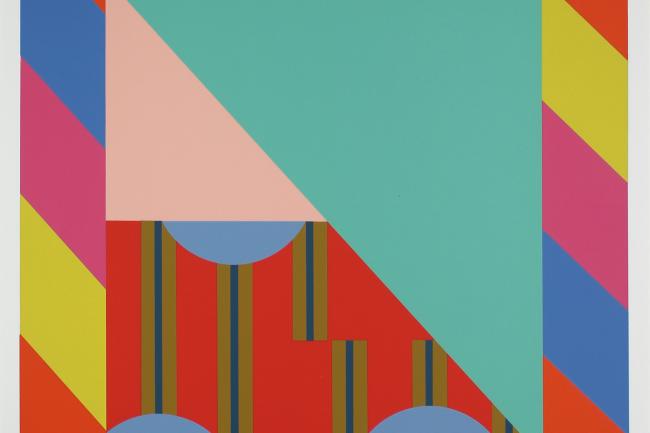Earl Miller: The Spiral Collective, lesson plan
Political activism and Racial Justice in Art
Created by Western Gallery intern Ariela Ikezawa
Files
| Attachment | Size |
|---|---|
| Earl Miller: The Spiral Collective, lesson plan - PDF for print (9.23 MB) | 9.23 MB |
Grades 9-12
Essential Questions
-
How does art help us understand the lives of people of different times, places, and cultures?
-
How is art used to impact the views of a society? How does art express the views of society?
-
How does knowing the context of the piece change how you look at this artwork?
“The Spiral collective coalesced during the remarkable period of American history that followed the emergence of Martin Luther King Jr. as a national leader of the Civil Rights Movement. The artists in the group were moved to gather to discuss their own engagement in the struggle for Civil Rights, and each resolved the question of engagement in a different way .”
Birmingham Museum of Art
The Spiral Group was a collective of Black artists formed for a brief period of time in the 1960s. A New York based collective, these artists came together to discuss the Civil Rights Movement, society, and politics with each other and the public through their art. The group included artists Charles Alston, Emma Amos, Romare Bearden, Calvin Douglass, Perry Ferguson, Reginald Gammon, Felrath Hines, Alvin Hollingsworth, Norman Lewis, Earl Miller, William Majors, Richard Mayhew, Merton D. Simpson, Hale Woodruff, and James Yeargans. One of the many ideas these artists considered was the best way to express their message.
While the group generally worked in a “modernist abstraction” style, “[a] major point of contention among the group was whether artists should illustrate the Black experience in figurative terms, or if Black abstraction itself was a politically radical form of artistic practice.” Many of the group ’s discussions talked about the power of the artistic response to social justice movements (specifically the Civil Rights Movement), and different visual aesthetics with which they could accomplish their goals.
Both of Miller's pieces in the Western Gallery exhibition Arbitrary Borders were created a decade after the Spiral Group dissolved in 1965. However, the visual impact of his time in the group can still be felt in his expressive abstraction, for example, Manhattan Savoy, (1975) is a portrayal of the city the Spiral Group was formed in.
Modernism
An art movement that embraced the innovation of techniques, materials, and subjects. Modernist art movements have been driven by social and political agendas and led to the creation of the abstract art movement.
Abstraction or Abstracted Art
Art that does not specifically represent a "realistic" depiction of the world and instead relies on shape, colors, forms, and other elements of art to convey its purpose.
Figurative Art
Art that specifically represents a realistic depiction of the world. Contains strong connections to the real world.
Visual aesthetics
The superficial beauty or visually enjoyable appearance of an object.
Civil Rights Movement
A social-political movement that took place between the mid-1950s through the 1960s in America, in which made a number of significant gains in furthering the equal treatment of different people in the United States through non-violent protest and civil disobedience.
Social Justice
The issue of equitable distribution of social goods and opportunities throughout society. Social justice movements are often connected to social problems centering on wealth and privilege.
- Anchor Standard: Relate artistic ideas and works with societal, cultural, and historical context to deepen understanding.
- Performance Standards: Describe how knowledge of culture, traditions, and history may influence personal responses to art.
- Artistic Process: Relating artistic ideas and work with personal meaning and external context.
I can evaluate how my understanding of an art piece changes as I learn more information about the context in which it was created, and convey to others the message that piece shares.
- Construction paper in a variety of colors (6 or more colors recommended)
- Tape or glue sticks
- Access to Earl Miller's work is available on the ArtsWA website.
This activity is inspired by Sharon Vatsky's book Museum Gallery Activities: A Handbook.This activity is designed to inspire wonder and encourage students to consider their own perspectives and approaches to art before viewing an artist's perspective. To do this students are posed a "problem": where the artist's style, approach, and/or artistic motivation are explained, but they are not shown images of the artists' work. Students are asked to "solve" the problem by creating their own artwork using the style and approach of the artist in question. Finally, students view the artist's work and make observations and comparisons between their "solution" and the artist's.
-
The artist Earl Miller (1930 -2003) often expressed his political views and participated in social justice movements through his art. He used color, lines, shapes, and patterns to express his beliefs. Students should select a current social movement to explore through their artwork (ex. Black Lives Matter or climate change). The instructor can also choose a movement that is related to class content for students to use.
-
Ask students to consider how they would express their opinions through artistic methods similar to those of Earl Miller. Remember, descriptions have been given of the artist 's style but students have not
seen the artworks in question at this stage. -
Students have the constraint of only working with torn paper.
-
Have students choose to work in either figurative or abstract methods before they begin. Have students write down why they chose their solution path.
-
Set out different stacks of colored construction paper.
-
Students should choose colors and create their pieces using only torn paper and glue sticks or tape.
-
Students should write down their reasoning for why they chose the colors they used, and any other artistic choices they made.
-
Example, “I thought about climate change. The colors I immediately thought about were blue and green and brown and gray.”
-
-
Optional: Gallery Walk for students to look at each other’s work
First Look at Earl Miller's work
-
As a class, students should quietly observe both Miller’s Stellar -2 (1976) and Manhattan Savoy (1975) for at least 5 minutes.
-
Students should take notes about anything they notice, from the colors used, what the message they see might be, and connections between their “solution” to the same “problem” of expressing their views about a social movement through art.
-
Once students have had the opportunity to form their first impressions of Earl Miller's work, move into a facilitated discussion about students' observations. Possible prompts for the discussion facilitator:
-
What ideas do you see in Miller's work that you might have used?In what ways did you approach the challenge of expressing your thoughts on a social movement through color and torn paper? How might this be different from Miller's method?
-
Miller worked in abstract art, can you see a message or a theme in his work? What elements in the work help tell his message?
-
What mood(s) can you identify? What elements of his work help convey that mood?
-
How do those different parts tell the viewer a message or story? Do you see a message or story?
-
If you stand up or sit on the floor, how does this piece look different? Does that change what sections you see?
-
-
Have each student say one thing they notice about the piece. While students cannot repeat an observation, they can add on to a previous idea.
-
What did you notice that was similar to someone else's observation? Did you notice something that was totally different from everyone else?
-
Then as a class, students will be fully introduced to the artist Earl Miller, and his participation in the Spiral Collective (found in the Overview section).
-
Give students an opportunity to share with a neighbor, partner, or table group to discuss new things they're thinking about now that they have more information.
-
As a class, do a second individual silent observation of Miller's Stellar - 2 (1976) and Manhattan Savoy (1975) for 2 minutes.
Second Look at Earl Miller's work
-
In small groups, students should have a second reflection discussion considering the following questions:
-
How did learning about Earl Miller’s history change how you looked at his work?
-
Did knowing more about Miller change the message you noticed in the art?
-
Why do you think he chose to make abstract work? Did that choice change his message?
-
What would you ask Earl Miller if you had the chance?
-
-
End the lesson with an individual reflection statement from each student on how they would approach their original challenge of expressing their own socio-political views using only torn paper now.
-
Would they change their approach? Explain why or why not.
Example Student Work

Example Artist Statement
I decided to do a figurative representation because I thought it would be easier to convey my message. As I was choosing my colors, I decided to use two different types of blue, green, and black and white to help show the environmental theme I was thinking about. I wanted to represent a clean Earth in bright colors and to show the creep of the inevitable human-caused destruction in simple black and white, using as straight an edge as I could tear to show how human industrial actions are going to destroy the Earth. I used the balled-up black paper to represent the dirty pollution that is covering the planet.

